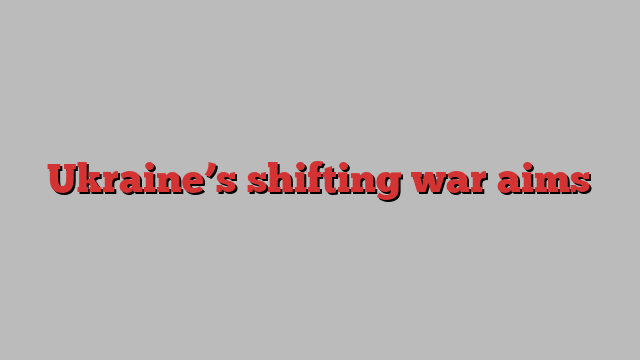
Unlock the US Election Countdown newsletter for free
The stories that matter on money and politics in the race for the White House
Ukraine is going into its third winter of war with the mood darker than ever. In the east, its troops are losing ground to the grinding advance of their Russian adversaries — albeit at vast cost to Moscow’s forces. With half its power generation shattered, Ukrainians face spending hours a day without light or heat in the coldest months. In Washington and some western capitals, meanwhile — and in the corridors of Kyiv — the mood is shifting: from a determination that the war can end only with Russia’s army driven from Ukraine, to the reluctant recognition that a negotiated settlement that leaves the bulk of the country intact may be the best hope. Yet Kyiv is not being given the support it needs even to achieve that scaled-back goal.
Ukraine’s prospects are clouded above all by the danger that Donald Trump wins next month’s US election and seeks a swift end to the war, as he has pledged. Some US and European officials hope Trump could at least be dissuaded from forcing Kyiv into an adverse deal with Moscow that would pose grave risks for future European and American security.
Yet grappling simultaneously with an escalating Middle East war, even some western capitals that previously insisted on the need to defeat Russia’s Vladimir Putin militarily are recalibrating their goals. Some Kyiv officials, too, fret in private that they lack the personnel, firepower and western support to recover all territory seized by Russia. There is talk behind closed doors of a deal in which Moscow retains de facto control over the roughly one-fifth of Ukraine it has occupied — though Russia’s sovereignty is not recognised — while the rest of the country is allowed to join Nato or given equivalent security guarantees. Under that umbrella, it could rebuild and integrate with the EU, akin to West Germany in the cold war.
This scenario relies, however, on ambitious assumptions. One is that the US and its allies must be prepared to offer Nato membership or the necessary guarantees, when they have so far been reluctant to grant Kyiv a binding path into the alliance. It would require a huge and costly deployment of forces by the US and its partners — and leave them on a cold war-style tripwire.
A second assumption is that Russia’s president can be induced to negotiate and accept such a scenario. But preventing Ukraine from joining Nato was one of his ostensible war aims. It is doubtful, too, that Putin has an incentive to agree to land-for-peace talks while he believes his forces can still expand their gains.
Ukraine’s president, Volodymyr Zelenskyy, presented a “victory plan” in Washington last month that sought to persuade Kyiv’s allies to bolster his position, militarily and diplomatically, and force Moscow to the table. He left empty-handed on two key requests: progress towards Nato, and US permission for Kyiv to use western missiles for long-range strikes on Russian territory.
Whether the goal is outright victory or bringing Russia to the table, western allies need to strengthen Ukraine’s hand. The Kremlin can only be pushed into talks on a deal that might be satisfactory for Kyiv, and the west, if it feels the costs of fighting on are too high. And any resolution to the war that enables all or part of Ukraine to survive and prosper will need guarantees of its security.
In his remaining three months in office, US President Joe Biden and his European allies should bolster Ukraine as much as possible. The aim ought to be to put Kyiv into the strongest possible position ahead of a Trump presidency, or to provide a foundation on which Kamala Harris can build if she prevails. We cannot yet know how the war will end. But it is within the west’s power — and interest — to help Ukraine regain the upper hand over its foe.